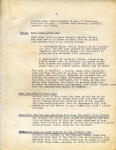Reuben B.
Robertson Collection
M1977.13.01.22
01
22
01
[robt_001a]
William Lanier Hunt, F.R.H.S.
Specialist in Southern Gardening and Civic Beautification
Chapel Hill, N.C.
April 26, 1939
Report on Hopewood, Estate of Mr. and Mrs. Reuben B. Robertson, Flat Rock, N.C.
Trees
Instructions for maintenance:
Rake off Pine needles; cover whole area with leaves from deciduous trees
(Oak, Hickory etc.) end then recover with the original needles for a
neat top finish. This operation will probably take the place of chemical
fertilizers which are dangerous in the case of mature trees because
these fertilizers destroy the delicate balance between the trees and the
soil after the trees have been starved for a long time. This
information applies chiefly to the White Pines.
The hemlocks under the White Pines can be fed with a half and half mixture (by bulk) of cotton seed meal and bone meal (medium ground bone--not "steamed bone" used for feed). The limbs of these trees which stick out into the road can be cut back as much as two thirds of their length the following spring after they have been fed. This must be done at sore tine before they come out.
Vista from North Terrace of House
Flowering trees in succession of bloom are definitely in order here because they are the only material big enough to make a show from the distance at which they must be planted--at the end of the vistas in the pasture. These trees must be protected from the cattle or any animals in the pasture until they are big enough to get above the danger line. Plans for this vista have not been completed, but the succession of bloom can be fairly complete, from early Spring throughout the Summer.
Front Driveway
In order to introduce some color to this section, it may be desirable to plant certain, shade-resistant azaleas and other plants in the more or less or en area--a strip running parallel to the driveway--just behind the White Pines and small Hemlocks. The pines and hemlocks would benefit from such a planting and, although it will always

Ravine Area about Trout Pool
This area, where we have already planted willows and some groups of Flame aza1eas, must be planted with extreme care as to certain things:
1. Continuous bloom. Native plants can be featured and added to with such exotics as are harmonious, lengthen the blooming season, are reasonable in price and are available from nurseries.
2. Development of pictures, vistas, interesting little nooks, etc. If the place is merely packed with flowers- and shrubs, there will be no effect except that of a stuffy place, jammed full of stuff.
The area is typically a dryish, sandy soil, decidedly acid and fine for certain azaleas and the pink Lady's-slippers. Here and there, Dogwoods are present but suffering for want of light. Apparently the forest was cut over, and they flourished, for a time, in the sunshine. Now, however, the trees are growing back, and in order to resuscitate the Dogwoods, the little scrubby that are shading them should be removed.
Area from Barn to Trout Pool
On each side of this road, the best effect can be obtained by keeping the shrubs back from the road some ten or fifteen feet and planting beds of the showier, dry-pine-woods-dwellers. Such an arrangement will take advantage of the beauty of tree trunks and avoid a stuffy feeling.
Area below the Dam and extending down into the Lower, Open Pasture
The springs and trails here should be opened up and certain sections will be fine for large plantings of such rare, wild flowers as Shortia and the Yellow Lady's-slipper which require, shade, moisture and leaf mold.
Streamside Area in Lower Pasture to the Boundary Line
Willows were planted at the boundary fence. Along the rich sections next to the stream, the semi-aquatics like Japanese Iris will do well. Care must be taken to slightly raise these beds, however, in order to prevent the

Little Pool in front of House
Only the very lowest plants should embellish the back of this pool and create atmosphere for the little figure to be done for it.
Lily Pool in Garden
Mr. Gattis has full specifications and a photograph for this pool with its four little bogs for growing interesting things like the Venus' Flytrap and Pitcher Plants.
